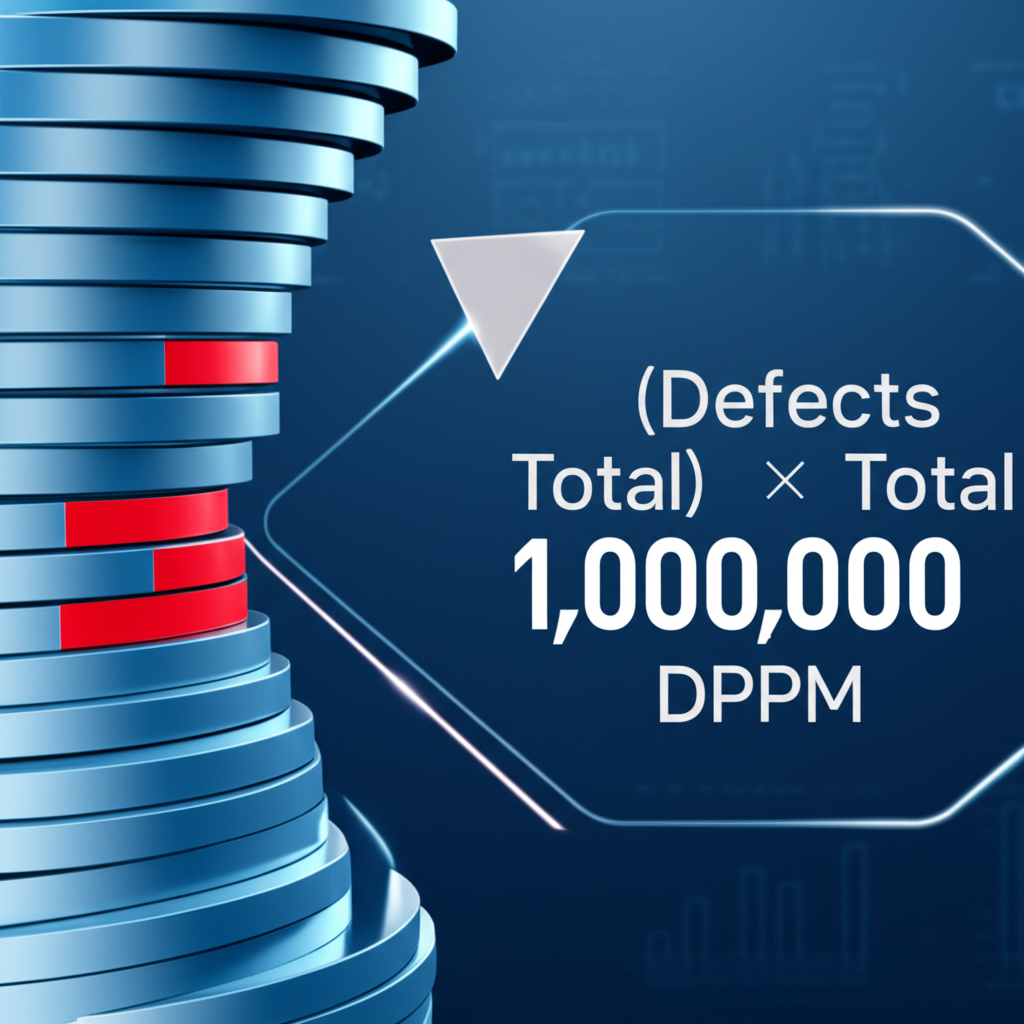DPPM in Manufacturing: Setting and Achieving Quality Goals

TL;DR
Defective Parts Per Million (DPPM) is a critical quality metric used in manufacturing to measure the number of defective units found in every one million parts produced. Setting a DPPM goal is fundamental for quantifying product quality, evaluating supplier performance, and driving a strategy of continuous improvement. The ultimate objective is often zero defects, but practical goals are benchmarked against industry standards to steadily reduce waste and enhance process reliability.
What is DPPM (Defective Parts Per Million)?
Defective Parts Per Million, commonly abbreviated as DPPM, is a standardized performance indicator that quantifies the rate of defects in a manufacturing process. In simple terms, it answers the question: "For every million parts we produce, how many are defective?" This metric provides a precise, numerical benchmark that allows companies to evaluate product quality, monitor process stability, and compare performance across different production lines, facilities, or suppliers.
The power of DPPM lies in its ability to scale quality measurement to a common denominator. Whether a factory produces thousands of parts or billions, DPPM translates the defect rate into a universally understood figure. A low DPPM value signifies a highly efficient and reliable manufacturing process, which is especially critical in industries with stringent quality requirements, such as automotive, aerospace, and medical devices. In these sectors, even a minuscule defect rate can have significant consequences for safety and performance.
Tracking DPPM is a cornerstone of modern quality management systems like ISO 9001 and IATF 16949. It moves quality assessment from subjective guesswork to objective data analysis. By monitoring this key performance indicator (KPI), manufacturers can detect subtle variations in process performance early, allowing them to address potential issues before they escalate into major problems that lead to scrap, rework, or costly recalls.
How to Calculate DPPM: Formula and Practical Example
Calculating DPPM is a straightforward process based on a simple formula. It provides a clear, data-driven view of your production quality. Understanding how to apply this formula is the first step toward leveraging DPPM for process improvement.
The formula is as follows:
DPPM = (Number of Defective Parts / Total Number of Parts Produced) × 1,000,000
To use this formula, you need two key pieces of information: the total count of parts manufactured in a specific lot or time period and the number of parts identified as defective within that same sample. The multiplication by one million scales the result to the "per million" standard, making it easy to benchmark and track over time.
Let's walk through a practical example. Imagine a facility produces a batch of 500,000 electronic sensors. Upon inspection, quality control teams identify 15 sensors that fail to meet specifications.
- Identify the number of defective parts: 15
- Identify the total number of parts produced: 500,000
- Apply the formula: DPPM = (15 / 500,000) × 1,000,000
- Calculate the result: DPPM = 0.00003 × 1,000,000 = 30
The result is 30 DPPM. This means that for every million sensors produced under these process conditions, an average of 30 will be defective. This single number provides a clear baseline for quality performance and can be used to set future improvement goals.

Setting DPPM Goals: What is a Good Target in Manufacturing?
While the ultimate ambition for any high-performance manufacturing operation is zero defects, setting practical and incremental DPPM goals is essential for driving realistic continuous improvement. A "good" DPPM target is not a universal number; it varies significantly based on the industry, product complexity, and customer expectations. For instance, the acceptable defect rate for a disposable consumer good is vastly different from that of a critical component in an airplane's navigation system.
Many world-class organizations benchmark their quality goals against the Six Sigma methodology, which aims for a defect rate of just 3.4 DPMO. Achieving this level signifies that a process is 99.99966% defect-free and is considered a gold standard in quality performance. However, reaching this target requires immense process control and statistical discipline. For many companies, the journey toward Six Sigma involves setting progressively lower DPPM targets over time.
Industry benchmarks provide a useful starting point for setting DPPM goals. According to Symestic, typical targets can range from under 10 DPPM for medical devices to under 50 DPPM for automotive suppliers and under 200 DPPM for general consumer goods. The automotive industry, in particular, places a heavy emphasis on minimizing defects to ensure vehicle safety and reliability. For robust and reliable automotive components, specialized suppliers are crucial. For example, companies like Shaoyi Metal Technology focus on high-quality, IATF16949 certified hot forging, providing the precision necessary to meet these demanding DPPM goals from prototyping to mass production.
The most effective approach is to establish a baseline DPPM by measuring current performance and then setting achievable, time-bound reduction goals. The focus should be on a path of continuous improvement, where each new goal pushes the organization closer to operational excellence and higher levels of quality.
The Strategic Importance of Tracking DPPM
Tracking DPPM is much more than a quality control exercise; it is a strategic tool that provides deep insights into the health of a manufacturing operation. When monitored effectively, DPPM data can drive significant improvements in efficiency, cost-effectiveness, and customer satisfaction. It transforms quality from a factory-floor metric into a C-suite concern, directly impacting the bottom line.
One of the primary strategic benefits is enhanced supplier management. By requiring suppliers to report DPPM, a company can objectively assess their performance. This data allows for apples-to-apples comparisons between vendors, helping to identify top-performing partners and those who may need to improve their processes. A low DPPM from a supplier ensures that high-quality materials are entering your production line, which is a critical first step in producing a defect-free final product.
Furthermore, a focus on reducing DPPM directly leads to significant cost reduction. Each defective part represents wasted materials, labor, and machine time. High defect rates lead to increased costs associated with scrap, rework, and warranty claims. By using DPPM data to identify the root causes of defects and implement corrective actions, companies can systematically reduce this waste. As outlined by 6sigma.us, minimizing defects is a core principle for boosting profitability and operational efficiency.
Ultimately, the pursuit of a lower DPPM enhances customer satisfaction and brand reputation. Consistently delivering high-quality, reliable products builds trust and loyalty among customers. In today's competitive market, a reputation for quality can be a powerful differentiator. The quest for zero DPPM, as discussed by Manufacturing Business Technology, is essential for mission-critical applications where failure is not an option and brand protection is paramount. By committing to a low DPPM goal, a company signals its dedication to excellence, which resonates with customers and strengthens its market position.

Driving Quality from Data to Action
Understanding and calculating Defective Parts Per Million is the first step, but the true value of DPPM is realized when it is used to drive meaningful action. It is not merely a historical record of failures but a forward-looking tool for continuous improvement. By setting clear goals, tracking performance over time, and empowering teams to investigate the root causes of defects, organizations can transform their quality culture. Ultimately, mastering DPPM helps a company move from a reactive approach of finding and fixing defects to a proactive strategy of preventing them from ever occurring, securing a competitive advantage built on reliability and excellence.
Frequently Asked Questions
1. What is DPPM in manufacturing?
DPPM stands for Defective Parts Per Million. It is a key quality metric that measures the number of non-conforming or defective units for every one million units produced. It serves as a standardized benchmark to assess the performance and reliability of a manufacturing process.
2. What is a good PPM target?
A good Parts Per Million (PPM) or DPPM target depends heavily on the industry. While world-class performance under Six Sigma standards is 3.4 DPMO, many industries have their own benchmarks. For example, automotive suppliers often aim for under 50 DPPM, while medical device manufacturers may target under 10 DPPM. The universal goal is continuous reduction.
3. How do you calculate DPPM in quality?
The formula to calculate DPPM is to divide the number of defective parts by the total number of parts produced, and then multiply the result by 1,000,000. For example, if 10 defects are found in a batch of 200,000 parts, the DPPM would be (10 / 200,000) * 1,000,000 = 50 DPPM.
4. What is the difference between DPPM and failure rate?
DPPM measures defects that occur during the manufacturing process, identifying parts that do not meet specifications before they are shipped. Failure rate, on the other hand, typically refers to the rate at which products fail during their operational life after they have reached the customer. DPPM is a measure of production quality, while failure rate is a measure of product reliability in the field.
 Small batches, high standards. Our rapid prototyping service makes validation faster and easier —
Small batches, high standards. Our rapid prototyping service makes validation faster and easier — 
